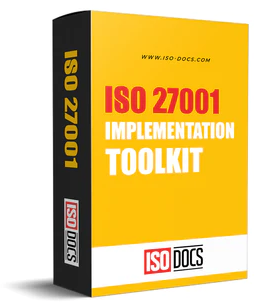What are ISO 27001 Controls?
In today's digital age, the security and protection of sensitive information have become paramount for organizations across various sectors. With the increasing frequency and sophistication of cyber threats, it is imperative for businesses to establish robust information security management systems (ISMS) that encompass a comprehensive set of controls.

The ISO 27001 standard is a globally recognized framework that provides guidelines for designing, implementing, maintaining, and continuously improving an ISMS. At the heart of ISO 27001 lie its controls – a structured collection of measures aimed at mitigating risks and ensuring the confidentiality, integrity, and availability of information assets. Let's explore the essential aspects of ISO 27001 controls, their classifications, and their significance in fortifying an organization's information security posture.
Understanding ISO 27001 Controls
ISO 27001 controls are a set of structured measures and safeguards designed to address information security risks. These controls are meticulously outlined in Annex A of the ISO 27001 standard and are grouped into 14 categories, each catering to a specific aspect of information security. The controls are flexible and can be tailored to suit the unique requirements of an organization, ensuring that security measures are aligned with business goals and risk tolerance.
Classifications of ISO 27001 Controls
The ISO 27001 controls are classified into two main categories: Annex A controls and additional controls.
1. Annex A Controls
Annex A of the ISO 27001 standard encompasses 114 controls distributed across 14 families, as follows:
- Information Security Policies (5 controls): Establishing clear and comprehensive information security policies and procedures that guide the organization's approach to information security.
- Organization of Information Security (7 controls): Assigning roles, responsibilities, and accountability for information security throughout the organization.
- Human Resource Security (6 controls): Ensuring the security of employees and contractors in relation to information security, including personnel screening and training.
- Asset Management (10 controls): Managing information assets throughout their lifecycle, from acquisition to disposal.
- Access Control (14 controls): Restricting access to information assets based on business and security requirements.
- Cryptography (2 controls): Utilizing encryption and cryptographic mechanisms to protect information.
- Physical and Environmental Security (15 controls): Safeguarding the physical environment and equipment that house information assets.
- Operations Security (14 controls): Ensuring the secure operation of information processing facilities and resources.
- Communications Security (7 controls): Protecting the security of information during its transfer.
- System Acquisition, Development, and Maintenance (13 controls): Integrating security into the development lifecycle of information systems.
- Supplier Relationships (5 controls): Managing information security aspects when working with suppliers and third parties.
- Information Security Incident Management (7 controls): Establishing an effective approach to detecting, reporting, and responding to security incidents.
- Information Security Aspects of Business Continuity Management (4 controls): Ensuring the organization's ability to continue business operations during and after disruptions.
- Compliance (8 controls): Ensuring adherence to legal, regulatory, and contractual requirements pertaining to information security.
2.Additional Controls
In addition to the Annex A controls, organizations may identify the need for supplementary controls that address specific risks or industry requirements. These additional controls enhance the overall effectiveness of the ISMS and provide a tailored approach to mitigating information security risks.
Significance of ISO 27001 Controls
The ISO 27001 controls play a pivotal role in an organization's information security strategy and have far-reaching implications:
- Risk Mitigation: ISO 27001 controls are meticulously designed to identify and address information security risks. By implementing these controls, organizations can systematically assess and mitigate vulnerabilities, reducing the likelihood and impact of security breaches.
- Legal and Regulatory Compliance: ISO 27001 controls facilitate adherence to various legal, regulatory, and contractual obligations related to information security. By complying with these controls, organizations demonstrate a commitment to safeguarding sensitive information and avoiding potential legal consequences.
- Business Continuity: Controls related to business continuity management ensure that an organization can maintain essential operations during disruptions. By formulating strategies and procedures for continuity, organizations can minimize downtime and potential financial losses.
- Supplier and Third-Party Relationships: ISO 27001 controls concerning supplier relationships establish a framework for managing information security risks associated with external partners. This fosters trust, enhances collaboration, and safeguards sensitive data shared with third parties.
- Incident Response and Recovery: Controls related to incident management empower organizations to detect, respond to, and recover from security incidents swiftly and effectively. This minimizes the impact of breaches and helps maintain stakeholder confidence.
- Competitive Advantage: ISO 27001 certification, achieved through the implementation of these controls, can serve as a competitive differentiator. It signifies a commitment to information security, which can bolster customer trust and attract partners and clients.
- Cultural Shift: The process of implementing ISO 27001 controls promotes a culture of security awareness and responsibility among employees. This heightened awareness can prevent accidental data breaches and foster a security-conscious workforce.
- Continuous Improvement: ISO 27001 controls support a cycle of continuous improvement by necessitating regular reviews, updates, and enhancements to the ISMS. This dynamic approach ensures that security measures remain aligned with evolving threats and organizational changes.

Conclusion
In a landscape fraught with cyber threats and data breaches, ISO 27001 controls offer a robust framework for organizations to safeguard their valuable information assets. These controls, whether outlined in Annex A or customized to address specific risks, establish a comprehensive and adaptable information security management system. By implementing ISO 27001 controls, organizations can mitigate risks, comply with regulations, ensure business continuity, and foster a culture of security. In doing so, they not only protect their own interests but also enhance their reputation, build trust with stakeholders, and contribute to the broader effort of maintaining a secure digital environment.


